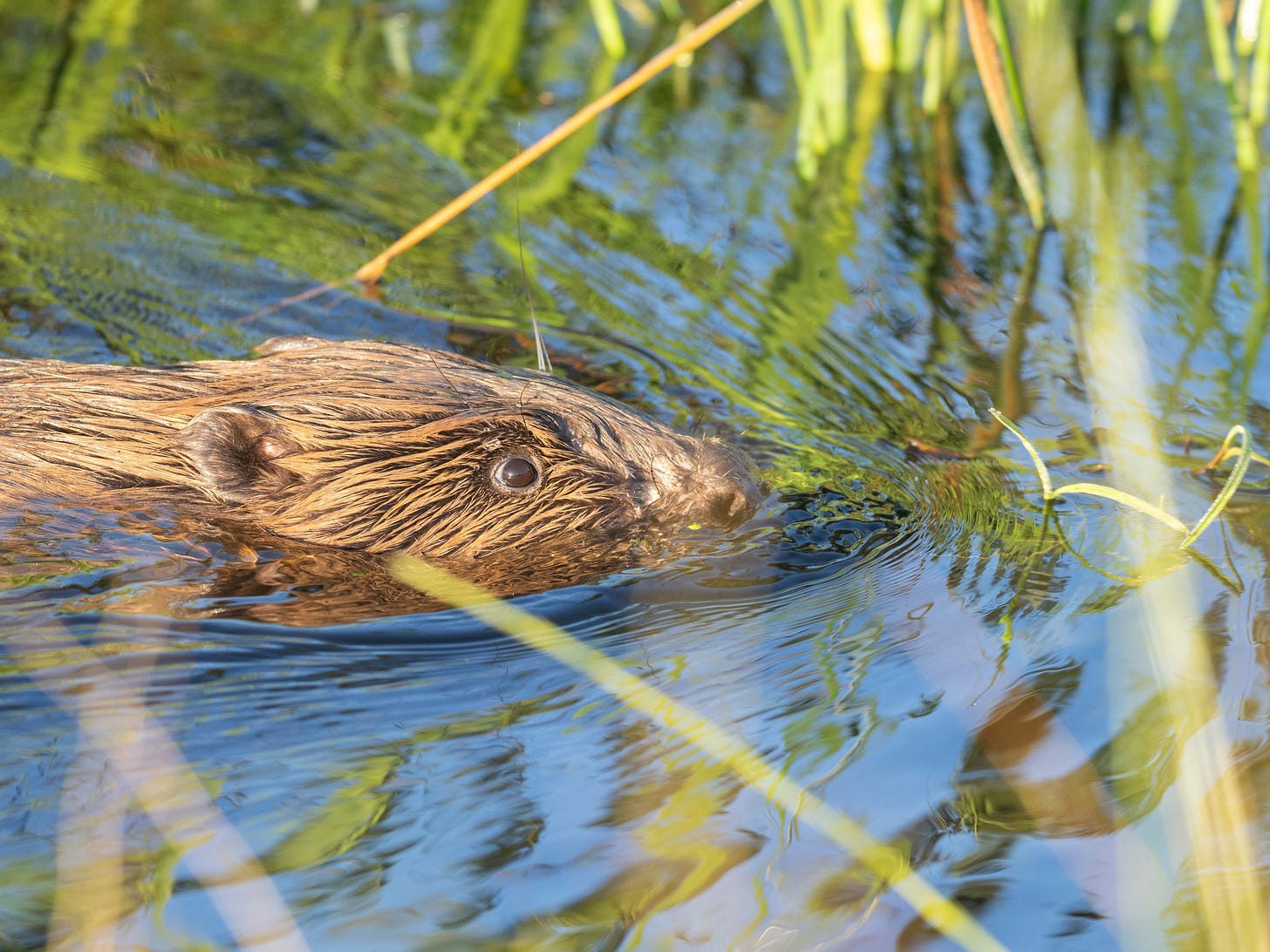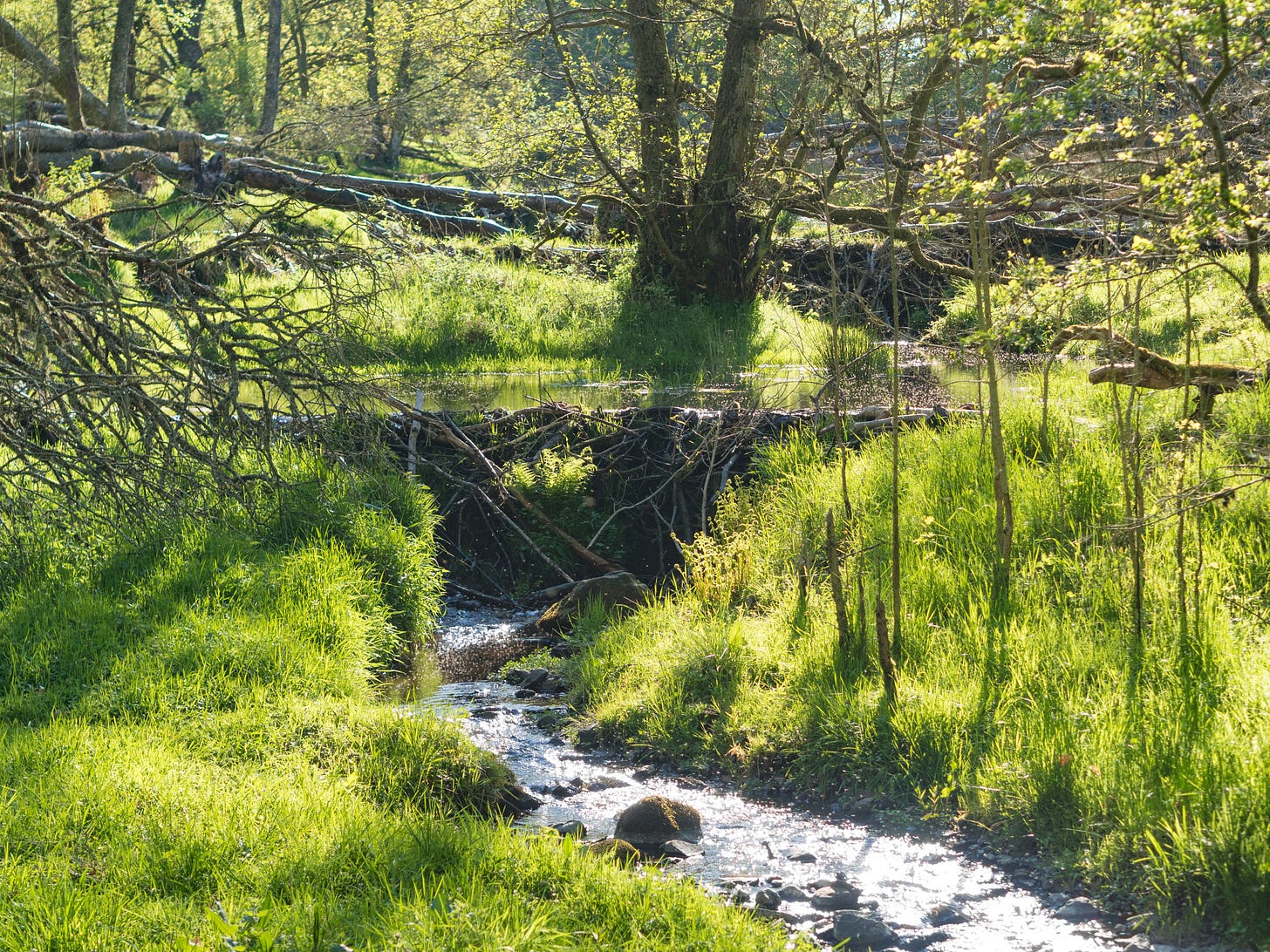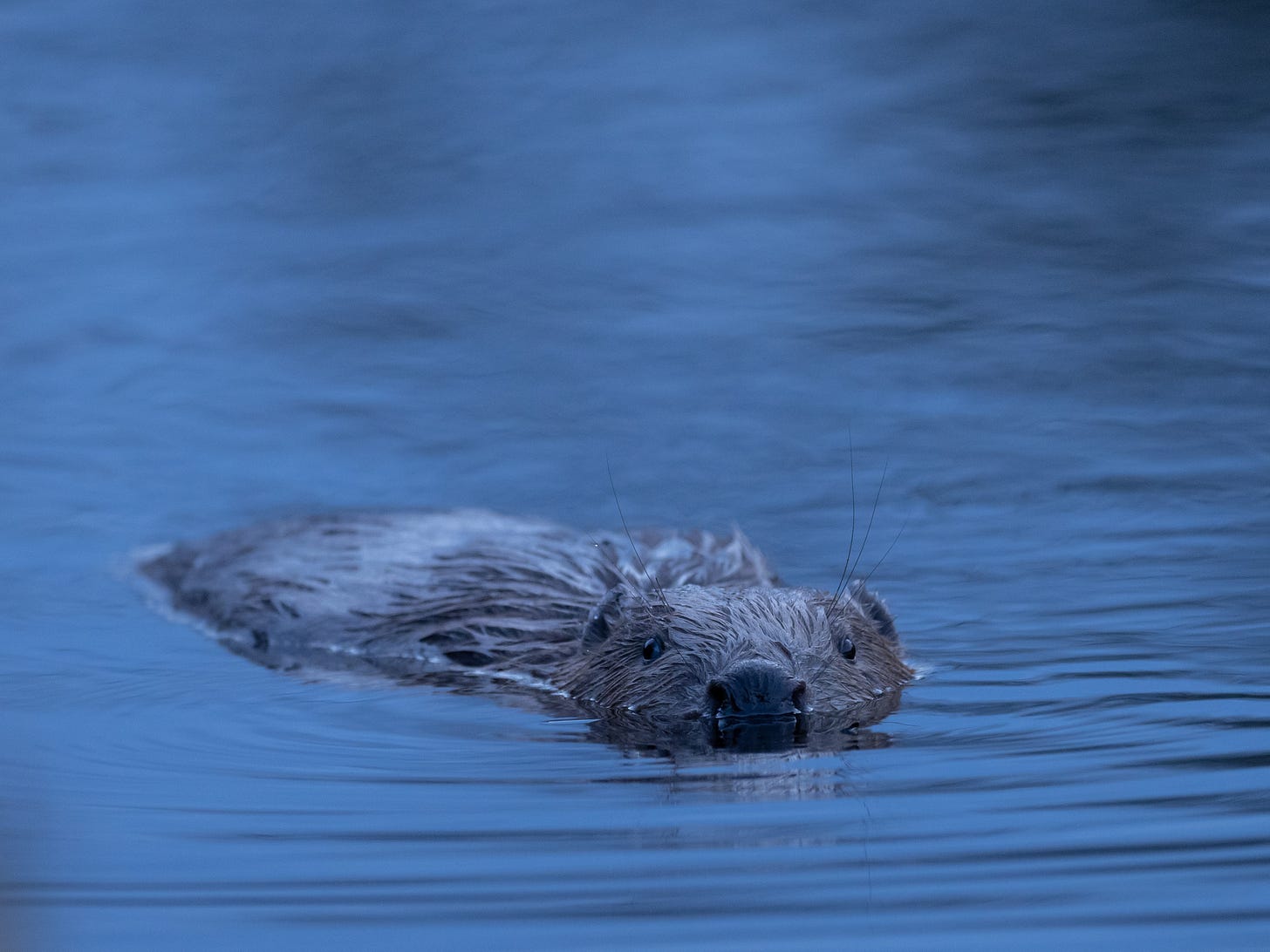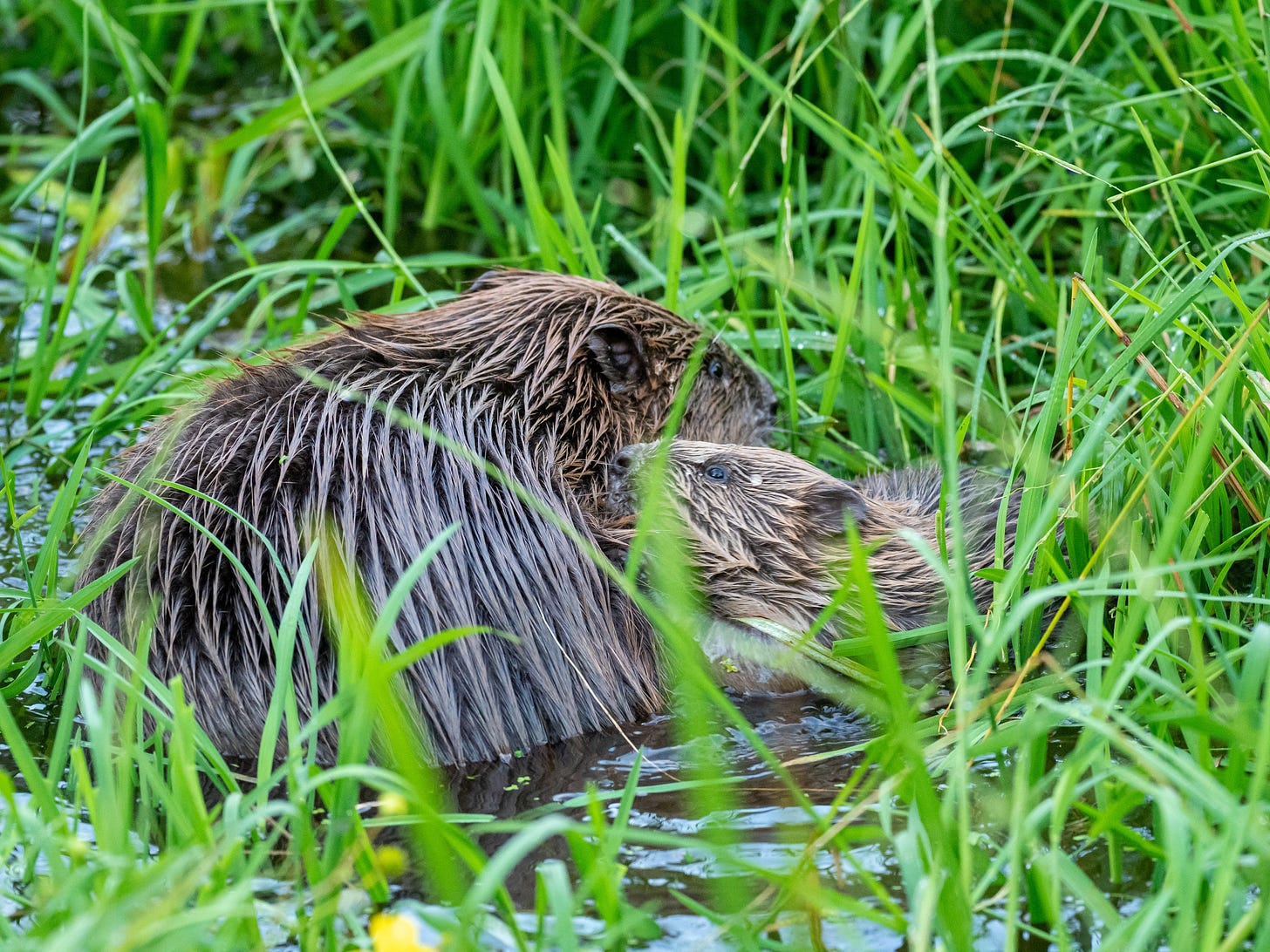The Magic of Beavers
Adam Ramsay recounts how his parents' adoption of beavers has transformed their upland farm into a rich, biodiverse haven for birds, mammals, fish and amphibians
My siblings and I used to build dams in a burn a short walk from the house. We’d use rocks and sticks to slow the flow and, sometimes, the level would briefly rise from ankle-deep to knee-deep.
If I tried to stand in the same place now, I’d be out of my depth. Just downstream from where our ramshackle barrages were, the professionals have moved in, and built a neat structure from tree trunks and turf. It’s about two metres high and maybe twenty metres wide, and holds back a long, deep pond, where, at dusk, you can watch the trout rise and the bats dive to feed on a zigzagging thicket of burgeoning insect life. And, if you’re lucky, the beavers themselves will slip into view.
This is just one of many dams they’ve built on my parents’ land in rural Perthshire, which have transformed it since my childhood from a low-productivity upland farm criss-crossed with drainage ditches, into a rich, biodiverse wetland, a haven for birds, mammals, fish and amphibians.
My dad had had a strong interest in what we now call rewilding ever since the 1980s. While many of my childhood memories revolve around rounding up his sheep, others involve overheard snippets of conversation about ‘natural regeneration,’ ‘ancient Caledonian pine forest’ and seeing birch thickets grow at about the same speed as me.
In the late 1990s, he went to a conference about Scotland’s declining biodiversity, where he learned that, until the 1600s, there had been beavers here, whose dams had created the wetlands on which hundreds of species relied. “Why,” he thought, “don’t we bring them back?”
He wasn’t the first person to have had this idea. But he was the first with appropriate land on which to do it.
Initially, there was some hope that the newly-formed Scottish parliament might move on the matter. But when the Labour-led Scottish Government ruled out reintroducing beavers, a gnarly group of frustrated ecologists decided to take action themselves.
I remember, as a teenager, trudging around a wet wood on my parents’ land with this group of scientists, led by my dad. Afterwards, they sat round the kitchen table and agreed: the terrain was right. This is where the first serious attempt to restore one of Britain’s lost mammals would begin.
The idea was simple. The beavers would be released within fenced-off areas. They would, legally, be a bit like pets. Similar sites would follow. When the nature agencies and Scottish Government realised that reintroduction was necessary to stop biodiversity collapse and flooding alike, there would already be a patchwork of populations in place. The fences could be taken down, and, rather than taking decades to spread out, the beavers would already be there.
The next question was, where do you get beavers? One pair came from Norway in 2002, but didn’t survive. Soon, a steadier supply presented itself. Gerhard Schwab is Bavaria’s Bibermeister. If a family of beavers has, say, built a dam which is flooding a road, it’s his job to find a solution – perhaps installing a flow device which pipes water through the dam, or sometimes moving the family. The next time he had to relocate a pair, he agreed, he would send them to Scotland. My parents ended up with two families, allowing some genetic mixing. And, later, sourced some for a friend with a farm downstream on the Tay’s flood plain.
Everything moved faster than planned. The year before my parents’ rodents were installed, three beavers escaped from a wildlife reserve elsewhere in the catchment. Later a flood meant that the growing family living at the other landowner’s place downstream swam over their fences.
During those early years, my dad started getting surreptitious phone-calls from people who had seen beavers, or signs of their presence, across the Tay river system. He explored for himself by canoe, discovering signs like wood chips next to felled trees. Now, it was just about waiting, and letting the rodents breed.
Meanwhile, the SNP now in charge, Scotland’s official nature agency finally got permission to launch its own reintroduction trial, on a peninsula in Knapdale, Argyll. Cut off, with the stone-lined Crinan canal on one side, and salt water (which beavers struggle in) on the other three, the location was clearly chosen to ensure the animals couldn’t spread: bureaucrats could claim to be doing something, while ensuring the minimum possible change actually happened.
It took nearly a decade for officialdom to acknowledge beavers had spread throughout the Tay catchment. When they did, they tried to round them up - to re-extinct them. But Taysiders - many of whom had grown fond of watching them work at dusk - wouldn’t have it. When Scottish Natural Heritage laid traps, some said that locals took to peeing on them, so their scent would warn off the beavers. My mum launched a Facebook group “Save the Free Beavers of the Tay!”, which exploded into a campaign.
In 2011, one beaver was live-trapped on the river Ericht, which runs through Blairgowrie. The local paper, the Blairgowrie Advertiser, sprang into action, naming her “Erica” and demanding her release. When Erica was – in the Blairgowrie Advertiser’s word – “imprisoned” in Edinburgh zoo, the newly formed Scottish Wild Beaver Group – led by my parents – adopted her on behalf of the local Beaver-Scouts group (of which, two decades earlier, I’d briefly been a member).
Before our beavers had produced young old enough to attempt to disperse, my father filmed some newborn kits in the wild. My Mum researched the EU Habitats Directive, and discovered that this meant that they were due for legal protection, since Scotland was part of their historic native range. But the Scottish Government dithered over confirming this line of EU law.
During the Scottish parliament election that year, a televised Question Time-type event came to Dunkeld, and angry audience members demanded to know if politicians would end the persecution of the free beavers. “Ah yes,” said the chair, “we’re in Perthshire. We always get questions about beavers in Perthshire.”
In 2016, the Scottish Government finally relented, and announced that beavers would be classified as a protected native species. But more trouble followed: while farmers now needed a licence to kill them, many licences were granted, and officials refused to sanction moving beavers whose locations caused trouble to new areas (even where the people there wanted them). Again, my mum hit the campaign trail, persuading her local MSP – the now First Minister John Swinney – that translocation was a better solution than shooting. Thousands put pressure on the Government via petitions and a judicial review. And in the 2021 Bute House agreement, the Greens negotiated a policy that beavers could spread around Scotland.
In the more than 20 years there have been beavers on my parents’ land, a string of scientists have studied their effects, finding, for example, that beaver dams trap pollution from farms, cleaning up water, boost invertebrate and water plant numbers, and are good for trout.
But you don’t need to be a scientist to see the improvements. Newt and frog armadas attract heron, goosanders, kingfishers, sandpipers, and dippers. Otters play. Last year, Ospreys nested.
Studies elsewhere have shown how beaver-created wetlands hold water back during rainy periods, preventing floods, and allow the trickle to continue during droughts. They’re crucial barriers against (increasingly common) wildfires. Their dams stop soil from washing downstream, slowing the terrifying rate of topsoil erosion.
This isn’t surprising. Our ecosystem evolved alongside beavers. Their penchant for building dams comes from a desire to create ponds so they can escape predators and transport food. But other species came to depend on those ponds, forming complex webs of relationships. Fungi and bugs evolved to harvest the woodchips they drop when they chop trees. Even the trees evolved alongside beavers: the species they tend to gnaw spring back, producing coppiced thickets of undergrowth which themselves create new ecosystems, often richer than the original vertical tree. The gaps left in the canopy let light in, helping this undergrowth flourish.
Eradicating beavers for their fur was one of the main ways that early capitalism damaged our ecosystems. Since they and their dams disappeared, the water and life have slowly drained from our landscapes. The temperate rainforests they help create have disappeared: in the last 500 years, England has lost around 90% of its wetland. The species which evolved to depend on beavers have collapsed: Britain’s lost two frog species since the 1980s. Numbers of Great Crested Newts and Common Toads have declined dramatically. Each of these species formed crucial parts of the diets of particular birds and mammals, meaning they, too, have suffered. And meaning that they, too, are benefiting from the beavers’ return.
There have been various schemes to restore England’s beavers in recent years, including some successful, unofficial schemes. But on 5 March 2025, the National Trust released the first officially sanctioned, unfenced beavers into the English countryside in more than four centuries. Two pairs now roam the Purbeck area of Dorset, likely greeting mating season with the business for which they’re famous. These beavers didn’t have to make the long journey from Bavaria. They’d been carefully trapped in Tayside, and travelled south: a part of the population of more than a thousand now thriving in Scotland’s biggest river system, some of which must surely be descendants of those shipped to my parents by Gerhard Schwab two decades ago.
The planet’s burning. Israel is committing genocide in Gaza. Trump’s crushing what remains of American democracy, and Starmer appears committed to performative cruelty. But these rodents are building dams to make ponds for frogs, toads and fish; insects, birds, and mammals. The ecosystems they create will, over the next few years, start to flourish. Life will revive.
Sometimes, amidst horrors, good things happen too.






Thank you for this heartwarming read Adam. I had scant idea of the struggle involved with officialdom in introducing this necessary and commonsense approach to shoring up our crumbling ecosystems.